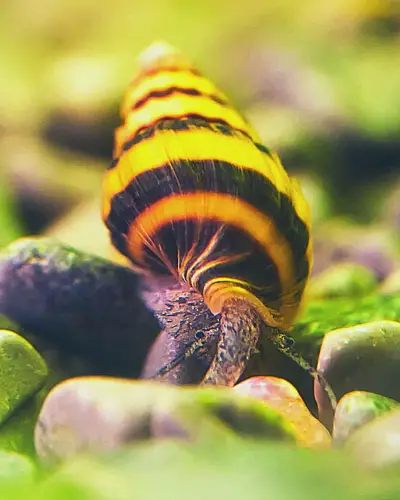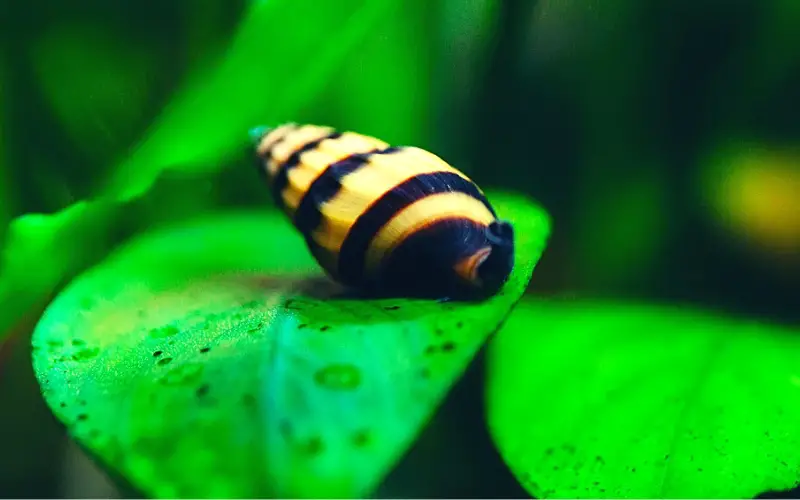The Clea Anentome Helena, also known as the assassin snail, might be the most intriguing critter you’ve never heard of. These small but mighty mollusks are gaining popularity amongst freshwater aquarium enthusiasts for their unique qualities and striking appearance.
But what exactly are Clea Helena snails, and why are they causing such a buzz? If you’re curious about adding excitement and natural pest control to your aquarium, buckle up!
This comprehensive guide will delve into everything you need to know about Clea Helena snails, from their fascinating behavior and ideal habitat to their dietary needs and breeding habits.

Whether you’re a seasoned aquarist or just starting your underwater journey, get ready to discover the captivating world of these fascinating creatures.
Table of Contents
ToggleWhy Is Clea Anentome Helena Snails Called an Assassin Snail?
The Clea Helena snail has earned the rather dramatic nickname “assassin snail” due to its unique dietary preferences. Unlike many other snail species that primarily graze on algae and vegetation, the Clea Helena snail is a carnivorous predator. Its favorite food?

Other snails! Assassin snails are particularly adept at hunting and consuming pest snails that can often overrun aquariums, such as Malaysian trumpet snails or pond snails.
They use their sharp radula (a tongue-like structure with tiny teeth) to pierce the shells of their prey and devour them, effectively controlling unwanted snail populations.
Delving Deeper: Biology and Ecology of Clea Anentome Helena Snails
Clea Anentome Helena snails, common name assassin snails, are freshwater gastropod mollusks from the Nassariidae family. First described by von dem Busch in 1847, these aquatic snails are native to Thailand and Southeast Asia.
Due to their unique conical shells and predatory nature, they are commonly kept in aquariums as part of the ornamental pet trade. They feed on other small snails in their natural habitat, making them a valuable asset to control pest snail populations in aquariums.
These freshwater snails require stable water quality and substrate in aquariums to thrive. They use their siphon to locate their prey and can retract into their shell to protect themselves when needed. Conscientious aquarists must provide a suitable environment for their Helena snails to ensure their well-being.
Clea Helena snails, native to Southeast Asia, possess fascinating biological and ecological traits that set them apart in the freshwater Anentome Helena Kaufen snail world.
Physical Characteristics:
- Size: These Gastropoda snails are relatively small, typically reaching about 1.5 to 3 cm in length.
- Shell: Their elongated conical shells exhibit beautiful patterns and colors, ranging from light brown to dark grey with intricate banding.
- Operculum: Like many aquatic snails, they have a trapdoor-like operculum that seals the shell opening when they retract inside, offering protection from snail-eating species.
Behavioral Traits:
- Predatory Nature: As discussed, their carnivorous diet and penchant for hunting other snails make them unique and valuable for aquarium ecosystems.
- Activity: They are primarily nocturnal, becoming more active in the evening hours to hunt for prey.
- Burrowing: Clea Helena snails enjoy burrowing into the substrate, so a soft sand or fine gravel substrate is ideal for them.
Ecological Role:
- Population Control: In their natural habitat and within aquariums, they play a crucial role in keeping populations of other snail species in check.
- Scavengers: While primarily carnivorous, they may also consume leftover fish food or detritus, contributing to overall tank cleanliness.
Water Parameters:
- Temperature: They prefer warmer temperatures between 72°F and 82°F (22°C – 28°C).
- pH Level: A slightly alkaline pH level between 7.0 and 8.0 is ideal.
- Water Hardness: They tolerate a range of water hardness but thrive in moderately hard water.
Understanding the biology and ecological role of Clea Helena snails is essential for providing them with a suitable environment and appreciating their unique contribution to the freshwater aquarium ecosystem.
What Is the Lifespan of an Anentome Helena?
The lifespan of an Anentome Helena, also commonly known as the assassin snail, is typically 2-3 years with proper care in captivity [aquarium roots].
There are some things you can do to ensure your assassin snail lives a long and healthy life:
- Provide a clean and well-maintained aquarium with good water quality.
- Offer a diet of meaty foods (other snails, shrimp) and sinking algae wafers.
- Maintain the proper water temperature (68-78°F) and pH (7.0-8.0).
Are Assassin Snails Invasive?
While Clea Anentome Helena snails, commonly known as assassin snails, have gained popularity among aquarium enthusiasts for their pest control abilities, they do have the potential to become invasive in certain circumstances.
It is essential to understand the factors contributing to their invasive potential and take necessary precautions to prevent any negative impacts on native ecosystems.
Assassin snails Clea helena are native to Southeast Asia, specifically regions like Malaysia, Thailand, and Indonesia. They play a crucial role in maintaining ecological balance in their natural habitat by preying on other snail species. However, when introduced to new environments outside their native range, they can disrupt local ecosystems.
If assassin snails are released or escape into natural water bodies, they may establish self-sustaining populations. Without natural predators or competition, they can rapidly reproduce and outcompete native snail mollusca species. This can lead to a decline in biodiversity and upset the delicate balance of aquatic ecosystems.
Do Assassin Snails Bury Themselves?
Yes, assassin snails can bury themselves. They bury themselves in the substrate or hide within the aquarium decor.
This behavior serves as a natural defense mechanism, allowing them to camouflage and protect themselves from potential predators.
Burying also helps them ambush and surprise their prey, as they can remain hidden until an unsuspecting snail or organism comes within their striking range.
Where to Buy Anentome Helena Snails?
You are finding Anentome Helena Snails for Your Aquarium: where to buy Anentome Helena near me? Locating these fascinating snails might be easier than you think! Several avenues can lead you to healthy Anentome Helena for sale:
– Local Fish Stores:
Start your search by visiting reputable local fish stores specializing in freshwater aquariums. They often carry a variety of snails, including Clea Helena snails, and their staff can provide valuable advice on care and compatibility.
– Online Retailers:
Numerous online aquatic shops offer Anentome Helena snails for sale, often with a wider selection than local stores. Choose a reputable dealer with healthy livestock and positive customer reviews.
– Aquarium Hobbyist Groups and Forums:
Connecting with fellow aquarium enthusiasts online or in local clubs can be a great way to find Anentome Helena hal tung snails. Hobbyists sometimes breed their snails and offer them for sale or trade.
Considerations:
- Health: Always choose active snails with intact shells, free from any signs of damage or disease.
- Quantity: Assess your aquarium’s size and the population of pest snails to determine how many snails you need.
- Compatibility: Research tank mates carefully to ensure compatibility with Anentome Helena haltung snails.
What are the Best Tankmates for Assassin Snails?
Assassin snails are popular aquarium snails because they help keep the tank clean by feeding on other snails. When it comes to finding suitable tankmates for assassin snails, it is important to consider the species’ compatibility.
One excellent choice is the bumble bee snail, a type of Buccinidae mollusc that can coexist peacefully with the assassin snail. Another good option is the tylomelania, a freshwater mollusk species known to keep the tank clean.
These tankmates can balance the aquarium’s ecosystem while ensuring that the anentome Helena Eier has enough food to thrive.
Overall, conscientious aquarists must carefully select tankmates for their snails to create a harmonious environment in the tank.
Aquarists can maintain a healthy and balanced tank ecosystem by choosing compatible species like the bumble bee snail and tylomelania. Additionally, regular monitoring and observation of the tank’s inhabitants can help ensure the well-being of all the snails and worms in the tank.
Commonly Asked Questions about Clea Helena Assassin Snail Care (FAQs)
Are assassin snails a good idea?
Assassin snails can help control pest snails, but they are not a magic bullet. They may also target desirable snails and can become a problem themselves if the food source (pest snails) runs out. Consider alternative methods first.
What gets rid of Anentome Helena snails?
Try trapping or removing them manually. For large infestations, consider fish like Yoyo loaches or dwarf puffers that eat snails.
Will assassin snails hurt fish?
No, They are snail hunters and won’t bother healthy fish. They’re too slow to catch them!
How long do Anentome Helena Snails snails live?
Assassin snails (Anentome Helena) can live up to 3 years in captivity with proper care in a well-maintained aquarium.
Do assassin snails carry disease?
Assassin snails themselves are unlikely to carry diseases harmful to fish. However, they could hitchhike on parasites or eggs from other snails. Consider quarantining new snails before adding them to your tank.
What is the gender of the assassin snail?
They have separate male and female sexes, but no external features tell them apart. Visually, it’s impossible to determine the gender of a single assassin snail.
Conclusion
As we’ve explored, the Clea Helena snail, or assassin snail, is much more than a pretty face in the aquarium. Its unique role as a natural pest control agent, fascinating behavior, and manageable care requirements make it a valuable addition to any freshwater tank.
By introducing these efficient hunters, you can say goodbye to the headache of snail overpopulation and create a balanced, thriving ecosystem for all your aquatic inhabitants. But the benefits extend beyond mere practicality.
Observing Clea Helena snails in action, gliding through the substrate and stalking their prey with surprising agility, offers a captivating glimpse into the complex predator-prey dynamics within our miniature aquatic worlds. Their presence encourages a deeper appreciation for the intricate web of life, even in seemingly simple environments like a home aquarium.
Moreover, the striking beauty of their patterned shells adds a touch of elegance to any tank setup. Whether you’re a seasoned aquarist seeking a natural solution to pest snails or a beginner looking to add some intrigue and diversity, the Anentome Helena snail is an ideal choice.
Recommended posts
- Assassin Snail Breeding 101: A Comprehensive Beginners Guide
- Assassin Snail Feeding 101: A Comprehensive Beginners Guide
- Assassin Snail Water Parameters: (Care Guide & Tank Set-Up)
- How Big Do Assassin Snails Get in Aquariums (Care Tips)
- Assassin Snail Temperature 101: Clea Helena (Expert Advice)
- Malaysian Trumpet Snail Infestation: (4 Secrets to Control!)
- Do Trumpet Snails Clean Aquariums: (5 Myths DEBUNKED!)
- Tarebia Granifera Aquarium 101: (A Comprehensive Guide!)
- Malaysian Trumpet Snails Lifespan 101: (Ultimate Care Guide)




